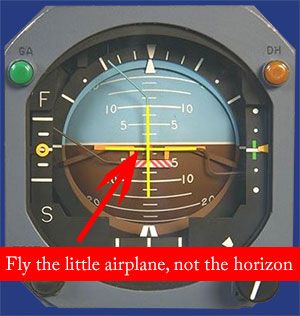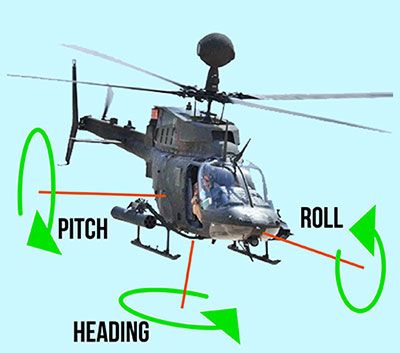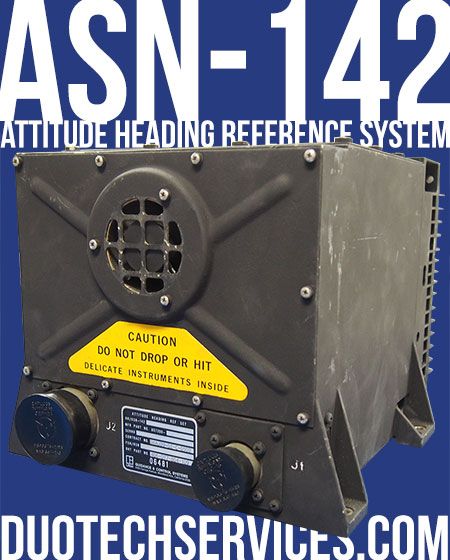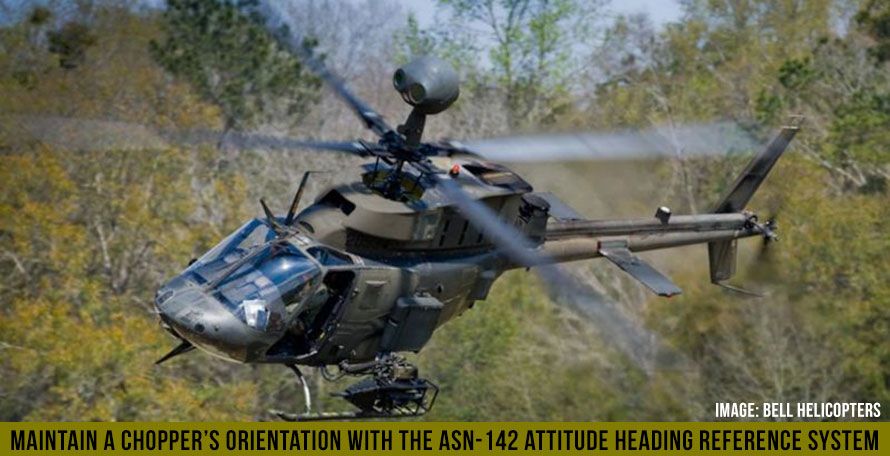Just about one hundred feet above a pine canopy in North Carolina, a Bell OH-58 Kiowa bobs and weaves through the air, returning from a Fire Control and Observation training mission. It is getting dark and the Kiowa whisks along, darting around obstacles. The pilot’s eyes cut back and forth from the terrain in front of his aircraft to the instrument panel inside the cockpit.

Ill. 1: Fly the little airplane, not the horizon
The numerous illuminated displays pass on important flight information to the pilot. For example, besides the radar providing weather conditions and location, other instruments indicate altitude, heading, speed, as well as the attitude of the aircraft. With the craft swaying back and forth in turns, the pilot monitors its orientation in relation to the earth below to avoid crashing into the trees or diving into the ground.
The attitude of an aircraft is its orientation relative to a reference line or plane, such as the horizon. Helicopters and planes use an attitude indicator, also known as an artificial horizon, to inform the pilot of the aircraft’s relative orientation to the Earth’s horizon. Part of this indicator includes the miniature airplane (Ill. 1) with two horizontal lines with a dot between them representing the actual wings and nose of the aircraft. Based on the orientation of the miniature plane compared to the horizon, a pilot can determine if the nose of the craft is pointed up or down and if his aircraft is banking.
The indicator receives its information from the Attitude Heading Reference System (AHRS). This AHRS consists of sensors on three axes (Ill. 2) that provide attitude information for aircraft, including roll, pitch, and yaw.

Ill. 2: AHRS provide attitude information for aircraft
It delivers aircraft attitude, heading and flight dynamics information to flight deck displays, flight controls, weather radar antenna platform, and other aircraft systems. To detect pitch and roll of the helicopter, the AHRS uses 3-dimensional magnetometers and accelerometers.
On the OH-58, the pilot uses his attitude indicator to understand the orientation of his helicopter. During the day hours in fair weather, it is easy to understand the aircraft’s attitude using visual orientation. But in low visibility conditions, the indicator allows the pilot to keep the helicopter flying in the right direction and at a proper angle.
The AHRS of the OH-58D is the AN/ASN-142. Its primary function is to furnish an inertial heading reference system that provides aircraft pitch, roll, heading, velocity, angular rate and acceleration data to the related fire control system in the Kiowa, and other helicopters like the UH-60 Black Hawk. The ASN-142 also augments the capabilities of the ASN-128 Doppler Navigation System.
An AHRS is usually made up of the following LRUs:
- An attitude heading reference unit (AHRU) – The major component of the system, contains the necessary power supplies, rate gyros, accelerometers and electronics to compute aircraft attitude, magnetic heading and rate of change and acceleration forces.
- A flux valve or magnetometer – Detects the horizontal component of the earth’s magnetic field and provides the long-term reference for heading data.
- A controller or panel-mounted switches – This panel holds the switches that tell the AHRS what mode to operate in, as well as some important annunciators. Some AHRS do not include a controller, and so the controlling switches and knobs are part of the instrument panel.
- A configuration module – Not every AHRS includes a configuration module. If one is present, this LRU provides the system information about which direction in the aircraft the unit is facing, if there is mounting misalignment, and other configuration discretes.

The AHRU of the AN/ASN-142, Attitude Heading Reference System
Attitude Heading Reference System
The LRU displayed here (Ill. 3) is the AHRU of the AN/ASN-142, Attitude Heading Reference System (NSN: 5821-01-187-0198 PN: 406-077-804-109) of the OH-58D and UH-60. A few other Attitude Heading Reference Systems associated with helicopters are the ASN-73 found in the CH-53A Sea Stallion, the ASN-143 assigned to the AH-64 Apache, and the ASN-145 of the CH-47 Chinook.
Maintaining Critical Electronics
These systems provide crucial data of a helicopter’s orientation to pilots to control and stabilize their aircraft, ensuring safety and mission completion. Maintaining critical electronics, avionics, and radar systems like a UH-60 Black Hawk’s AHRS, an F-16 Fighting Falcon’s Pulse Doppler Radar, and even the HUD of an F-5 Tiger II are essential to a nation’s security.
Duotech has over 34 years of experience providing a full range of equipment repair services. We provide Depot Repair Services for a wide variety of electronic and electromechanical systems for military and commercial applications. Find your part and contact us to answer your questions or Request a Repair Quote.








